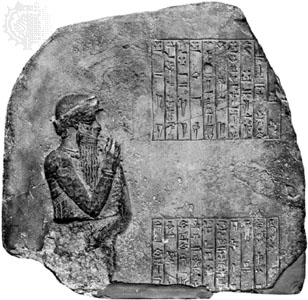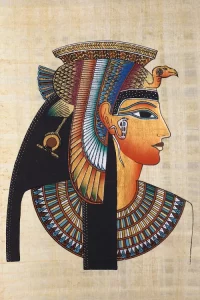Who would become the first king of the Babylonian Empire as well as gain fame for his creation of a law code? From conqueror to administrator, Hammurabi ruled over the Babylonian Empire during the years from 1792 to 1750 B.C.E.1 Hammurabi improved upon the techniques that the Akkadian ruler Sargon I had used previously to govern, which included bureaucratic rule and regular taxation.2 The most influential contribution on behalf of Hammurabi was his code of law. Although Hammurabi introduced the code towards the end of his reign, it was nonetheless influential.
Mesopotamian Law at that time was the most extensive form of law to have existed.3 The code helped Hammurabi establish order between all the diverse groups of people under his control. After conquering various groups of people, Hammurabi needed to bind these different groups together.4 Hammurabi gathered his people at the city of Babylon and unveiled a stele (stone slab).5 Hammurabi claimed to have come upon the laws through the god of Babylonian justice, Shamash. It was Hammurabi’s belief that the god had chosen him to deliver the laws to his people.6 The stele contained 282 laws to govern the people of his empire.7
Furthermore, the laws dealt with a variety of aspects of human life within the empire. The code illustrated major and minor offenses as well as their punishments. More often than not, the punishments were either death or a monetary fine. The code was written in cuneiform (a writing form adopted from the Sumerians), but the laws were carved in the Akkadian language. An example of the kinds of laws the Code contains can be seen in its first statute: “If a seignior accused a[nother] seignior and brought a charge of murder against him, but has not proved it, his accuser shall be put to death.”8 A monetary example is rule number two-hundred twenty: “If [a physician] opened his eye-socket with a bronze lancet and has destroyed his eye, he shall pay one-half his value in silver.”9
It is important to note that the Hammurabi Code made a strong distinction between social classes. For example, in sections 196 to 199 the Code reveals the application of the legal principle lex talionis (Latin for law of retribution). When a seignior (free man) commits a wrong to another seignior, the penalty was that the same infraction would be administered upon the perpetrator.10 However, if a seignior committed that same wrong to someone of a lower social class, the accused seignior did not have the same wrong attributed back. However, if a poor man is wronged, then one can simple pay a fee. Evidence for the social distinction is illustrated well with rules 196 and 198. Rule 196 states, “If a seignior has destroyed the eye of a member of aristocracy, they shall destroy his eye.”11 However, on the other hand, rule 198 states, “If [a seignior] has destroyed the eye of a commoner or broken the bone of a commoner, he shall pay one mina of silver.”12 It is believed that the typical phrase “an eye for an eye” became the core principle for Hammurabi’s Code. The slaves were even below the other two classes as evidenced with rule 199, which states, “If [a seignior] has destroyed the eye of a seignior’s slave or broken the bone of a seignior’s slave, he shall pay one half his value.”13

The stele containing the law code was displayed out in the public. The purpose was so that everyone could see the law. However, there was a slight issue: most people at that time were not literate. Therefore, although the law was displayed, very few were actually able to read and comprehend it. The rich and elite were favored while the poor and women were not treated equally. As a result, the Code became a reflection of the distinctions between the social classes, and between gender roles as well.
Hammurabi’s code would appear to be quite controversial and simplistic in the view of modern society. However, the code proved to be effective throughout Hammurabi’s reign. A point of controversy that arises from Hammurabi’s Code is the wording within the code. As opposed to modern law’s use of statements such as “this is not allowed” or “it is illegal to…” Hammurabi’s Code pursued more of “action X results in consequence Y.”14 An example to illustrate such process is as follows: if someone steals something (action X) the result is the death of the accused (consequence Y).
Although society has now progressed beyond the time of Hammurabi in several aspects of human society such as in law, it is important to analyze the roots of those developments. Furthermore, there also lies importance in drawing similarities between the past and modern society. How does modern society differ from Hammurabi’s in terms of social status and laws? Does modern law treat everyone equally in society? If not, then what similarities does modern society share with Hammurabi’s time? Human society is able to gain insight into the origins of contemporary social, political, economic and cultural problems.
- Ronald Wallenfels, ed., “Hammurabi,” in World Eras, vol. 8, Ancient Mesopotamia, 3300-331 B.C.E. (Detroit: Gale, 2005), 283. ↵
- Jerry H. Bentley, Herbert F. Ziegler, and Heather E. Streets-Salter, Traditions & Encounters: A Brief Global History, Fourth, vol. 1 (New York, NY: McGraw-Hill Education, 2016), 10–12. ↵
- Don Nardo and Robert B. Kebric, eds., “Hammurabi (Reigned Ca. 1792–1750 B.C.),” in The Greenhaven Encyclopedia of Ancient Mesopotamia (Detroit: Greenhaven Press, 2007), 134–35. ↵
- Brian Bonhomme and Cathleen Boivin, eds., “Code of Hammurabi,” in Milestone Documents in World History: Exploring the Primary Sources That Shaped the World, vol. 1, 2350 BCE – 1058 CE (Dallas, TX: Schlager Group, 2010), 16. ↵
- Jennifer Stock, ed., “Hammurabi Establishes a Legal Code,” in Global Events: Milestone Events Throughout History, vol. 5, Middle East (Farmington Hills, MI: Gale, 2014), 38–40. ↵
- Jennifer Stock, ed., “Hammurabi Establishes a Legal Code,” in Global Events: Milestone Events Throughout History, vol. 5, Middle East (Farmington Hills, MI: Gale, 2014), 38–40. ↵
- James B. Pritchard, ed., Ancient Near Eastern Texts Relating to the Old Testament, Third Edition (Princeton, NJ: Princeton University Press, 1969) 177. ↵
- Pritchard, ed., Ancient Near Eastern Texts, 166. ↵
- Pritchard, ed., Ancient Near Eastern Texts, 175. ↵
- Alfred J. Andrea and Carolyn Neel, eds., “Hammurabi’s Law Code and the Tripartite Structure of Mesopotamian Civilization,” in World History Encyclopedia, vol. 3, Era 2: Early Civilizations, 4000-1000 BCE (Santa Barbara, CA: ABC-CLIO, 2011), 150–51. ↵
- Pritchard, ed., Ancient Near Eastern Texts, 175. ↵
- Pritchard, ed., Ancient Near Eastern Texts, 175. ↵
- Pritchard, ed., Ancient Near Eastern Texts, 175. ↵
- Bonhomme and Boivin, eds., “Code of Hammurabi,” in Milestone Documents in World History: Exploring the Primary Sources That Shaped the World, vol. 1, 2350 BCE – 1058 CE, 18. ↵



33 comments
Micheala Whitfield
An eye for an eye! Hammurabi’s code is such and interesting topic. Well written, I enjoyed the simplicity of describing the way the code came about. I would have like to see more detail in the codes and more in depth about which codes transferred into modern society. I enjoy Hammurabi’s code. Sometimes it should be an eye for an eye. What both have in common is the same issue as the beginning. Both laws and codes have a difference in social and gender aspects. The poor, middle, and rich class all get different penalties on where they stand in society. It is also a known fact that women are still to this day fighting for equal rights. I think modern society need to adapt the structure of how the code was written. As the example you wrote, “You do (X) the punishment is (Y)” Simple. Concrete and you know what you get when you do the crime. There is so much to describe and go into with Hammurabi’s code. Nice work.
Arturo Canchola
I remember Hammurabi’s Code from my World History course in high school. It was a very effective means of controlling a large and diverse population in the ancient times. The common phrase “an eye for an eye” never fails to remind me of the interesting (and usually harsh) punishments they would dole out to those who violated the Code. One thing this article reminded me of was that this code wasn’t always just — richer people would get less of a punishment than their poorer counterparts for the same crime. However, the Code was still an effective way of controlling the masses in ancient history, and likely set a precedent for many other early forms of government.
Christopher Hohman
Nice article. Hammurabi’s code was quite an accomplishment back in the ancient times. It had many different punishments for many different crimes. It was however a little unfair because sometimes people of lower class were given stricter punishments for similar crimes. That is very unfair and even today sometimes wealthy people are held above the law. But this code is still very important in the formation of modern law.
Luke Lopez
This was a very interesting article on Hammurabi’s Code of Law. This Code magnified the distinctions in social classes, as the wealthy and educated were able to read and comprehend the law, while the poor and illiterate were not able to read and comprehend the law. Overall, this was a great article that went into depth on Hammurabi’s Code of Law, and its ramifications for the Babylonians at that time.
Martina Rodriguez
The first paragraph does a good job of giving the context of Hammurabi’s Laws and providing a good roadmap for his story. I have to say the story of the Steele reminds me vaguely of Moses and the Ten Commandments. I have to say that I liked the fact that the punishments weren’t just “an eye for an eye” (which I had been told before reading this article), rather that you could also have the option of paying a monetary fine.
Brianna Ford
This article was a very good read and it was a very informative. I find it amazing that the Hammurabi’s code of law was the first established laws in history. I did not like, however how the law was displayed differently between the wealthy and the poor. The wealthy would get a slap on the wrist whereas, the poor would be punished to something horrible or death.
Emily Jensen
The Code of Hammurabi is such a critical point in our history as humans, it is really when order was established in the Babylonian Empire. The distinction that the Code created between the different social classes is very interesting to me, a direct reflection of several systems that we still have in place today, like our tax system for example.
Roman Olivera
Hammurabi’s Code of Law is crazy to think about. It is truly the beginning of the modern law system, where a just punishment is the consequence for every law broken. Though at the time that the code of laws was used some of the punishments seemed a little extreme as far a putting someone to death for an injustice or broken law that did not include death. We still see similar laws in affect today countries that still employ similar practices to the code, such as cutting a persons hand off for stealing. Though this may be a good way to remind someone to never steal again, it is inhumane and rather primitive. I also see little change in the way the punishments under the laws are handed down in society today. If you are of a common social status you seem to be judged and charged more harshly that those who are wealthy. Like the saying goes, money talks! Unfortunately this should not be how it is in a more civilized society, but the greed of man and corruption of government are always a factor in society. Great article that has me thinking if society has really came as far as we think it has, or are we just doing the same things that they did in the time of Hammurabi’s Code of laws, just in a different way.
Hector Garcia
I think Hammurabi’s Code might have been the very first laws to had ever been established. Although these laws might have been the first one, there was only one downfall. That they were equal to every citizen in Mesopotamia. It also surprised me that many people weren’t literate and weren’t able to read the published laws. Overall, I thought it was a unique and iconic article.
Kimberly Simmons
The Code of Hammurabi was one that governed both the people and the geocentric universe. Though I have heard of and learned about these laws before, this article opened up a whole new window in understanding the origin of the codes. To look at the laws from this time period and compare it with the laws of today, it’s interesting to see how they compare and contrast.